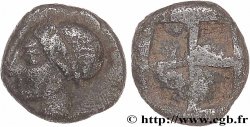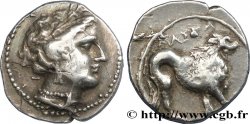bga_952216 - MASSALIA - MARSEILLE Hémiobole à la tête de bélier à gauche, du type du trésor d’Auriol
Not available.
Item sold on our e-shop (2024)
Price : 180.00 €
Item sold on our e-shop (2024)
Price : 180.00 €
Type : Hémiobole à la tête de bélier à gauche, du type du trésor d’Auriol
Date: c. 470-460 AC.
Mint name / Town : Marseille (13)
Metal : silver
Diameter : 7,5 mm
Weight : 0,56 g.
Rarity : R3
Coments on the condition:
Flan court et centré. Beau relief au droit. Patine gris sombre
Catalogue references :
Predigree :
Cet exemplaire provient de la collection Norbert MICHAUD, fameux collectionneur d’art japonais
Obverse
Obverse legend : ANÉPIGRAPHE.
Obverse description : Rhyton, tête de bélier à gauche, avec la corne enroulée ; le col perlé.
Reverse
Reverse legend : ANÉPIGRAPHE.
Reverse description : Carré creux irrégulier.
Commentary
A. Furtwängler distinguait cinq groupes pour cette abondante série (Q, Qa, Qb, Qc et Qd). Les auteurs du Dicomon suivent de classement en rajoutant un groupe OBA-Qg pour les monnaies légères (dont le poids varie entre 0,23 et 0,31 gramme).
Cet exemplaire avec la tête à gauche et 0,76 gramme semble pouvoir s’intégrer dans le groupe Qa.
Cet exemplaire avec la tête à gauche et 0,76 gramme semble pouvoir s’intégrer dans le groupe Qa.








 Report a mistake
Report a mistake Print the page
Print the page Share my selection
Share my selection Ask a question
Ask a question Consign / sell
Consign / sell
 Full data
Full data









